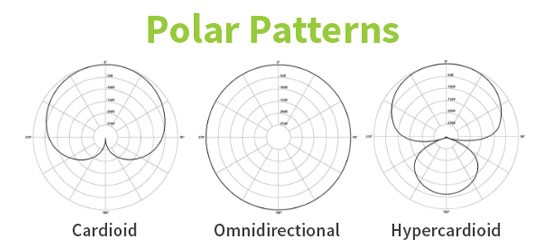Mic Polar Patterns … The short story!
The aim here is to provide a very brief overview of the common microphone Polar Patterns found in a church setting.
The polar pattern tells us about the sensitivity of a microphone to picking up sounds from different directions relative to the microphone’s orientation. It is normally represented on a polar chart and may or may not include the pattern for multiple frequencies. This pattern of sensitivity can help us understand how to best use a particular microphone.
Polar Patterns – A Pictorial Guide
There are many different polar patterns, but before we look at the 3 most common patterns found in a church setting we should make sure we know how to read a polar chart.

- 0o is facing into the top/front of the mic, 180o is behind the mic.
- The outside line is 0dB, each line toward the centre is (usually) -5dB or -6dB but always look for values on the graph.
- The closer to the centre a point on a frequency line lies on the chart, the less sensitive the mic is to sound from that direction at that frequency.
Many polar charts show the pick-up pattern for different sound frequencies, others have a single line such as the charts below showing the 3 most common patterns found in a church setting.

Using what we now know about reading a polar chart, we can interpret the above patterns as follows:
- An Omni directional microphone picks up sound with equal sensitivity from every direction – omni = every.
This means they are (generally) not good for noisy settings such as on stage with a band playing. They are good when the main sound source is close to the mic and there is little to no background noise. This makes them great for headset or lapel mics which is their most common application in a church setting. You can use an omni-directional headset mic for a vocalist quite successfully, but it takes careful management of the mic settings to avoid stage spill.
- The word Cardioid is Greek for “Heart” and this describes the pattern of this polar type.
A Cardioid microphone is most sensitive when sound comes directly at the top or front of the mic. The sensitivity then rolls off as the sound direction moves to the side of the microphone and continues to decrease as it moves to behind the microphone until being 0dB at the very back – forming that heart shape.
Note that the cardioid sensitivity shape will be most prominent for higher frequencies and lower frequencies will tend toward omnidirectional patterns.
Rejecting sound from behind the mic and reduced pick-up from the sides is what makes these microphones great for use on stage for vocals or for instruments. Make sure you pick the mic designed for the purpose you want to use it for -that is, get a vocal mic for vocals and the correct instrument mic for the instrument being played because there are other characteristics that affect the mic’s suitability for vocals or types of instruments.
- Hyper-Cardioid, or the very similar Super-Cardioid microphone, has an unusual shape. The microphone sensitivity drops off quickly to the sides to a maximum rejection (or minimum sensitivity) point that is behind and off to the left or right of the microphone.
Immediately behind the microphone there is an increase in sensitivity again. The angle to the left or right varies slightly (about 14 degrees) between Hyper and Super-Cardioid but the important principle is the same. Again, this is for higher frequencies, and lower frequencies will tend toward omnidirectional patterns.
With a rapid increase in noise rejection and a tight polar pattern, these mics should be even better than Cardioid mics for use with the band, right? Unfortunately, that is often not the case in reality. Super cardioid mics require practice to develop the good and disciplined mic technique required to reliably use them well. This means they are not as forgiving as a cardioid mic and so not great in an environment where microphones are shared, such as a church setting.
The increased sensitivity at the rear of the mic can also be problematic in a church setting where stage noise, poor mic technique, noise from the congregation, and even speaker placement or reflected sound can lead to noise and feedback. To be safe, it is best to opt for a cardioid microphone and avoid potential problems.
The examples above cover the most common polar patterns found in a church setting but, using the principles discussed, you should be able to read and interpret any polar pattern diagram for any microphone. From there you can then make an informed decision as to whether that pattern of mic will suit the purpose for which you want to use it. You should also be able to work backwards from the purpose and environment the mic will be used in to work out which pattern would be suitable.
